These images are a continuation of yesterday’s post and they focus more on sapsucker behavior. I’ve documented some of these behaviors previously but with a single exception each of these photos is new to my blog.
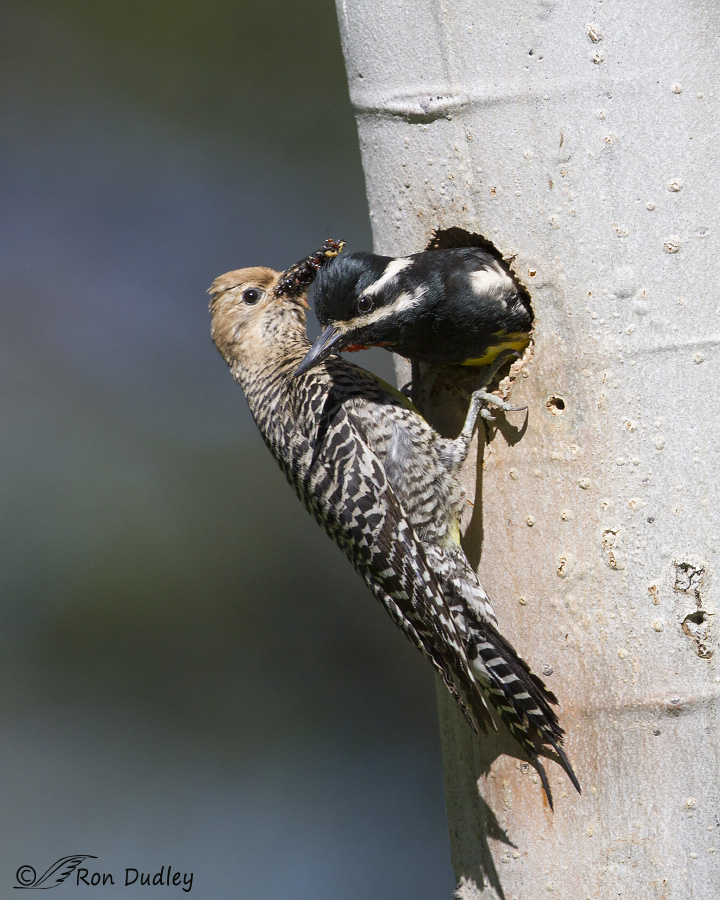
1/3200, f/5.6, ISO 500, Canon 7D, Canon EF 500mm f/4L IS USM, not baited, set up or called in
The male and female were equally industrious in caring for their young. Yesterday’s post included an image almost identical to this one except the roles of the sexes were reversed – here it’s the female delivering ants to the youngsters as the male exits the hole after delivering his own load of ants.
Yesterday I mentioned that when one woodpecker left the hole with the other one at the entrance, the bird on the outside was always careful to move its head out of the way to avoid having it taken off by the explosive exit of the other bird leaving.
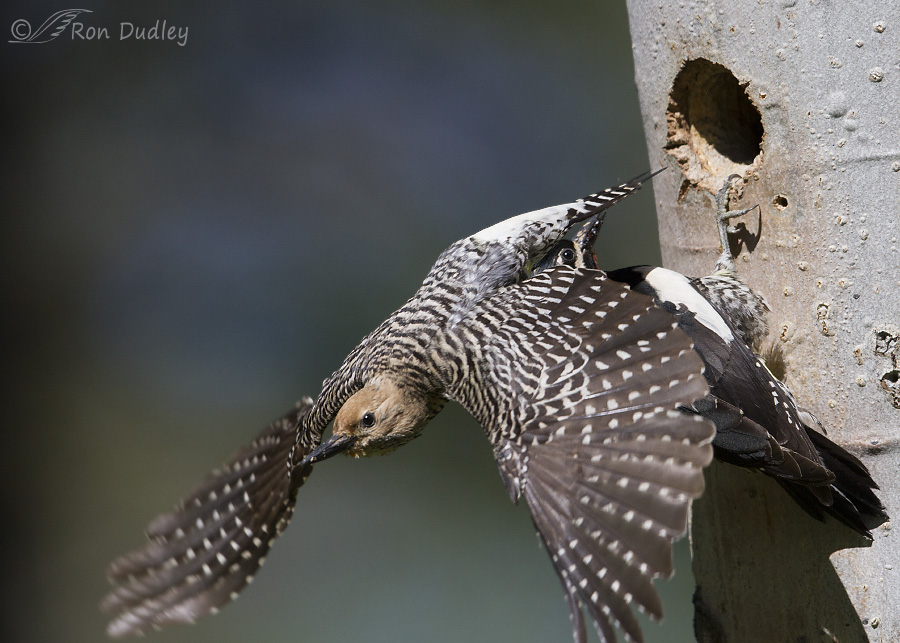
1/3200, f/5.6, ISO 500, Canon 7D, Canon EF 500mm f/4L IS USM, not baited, set up or called in
This image illustrates my point – as you can see there’s very little margin for error. Yes, I was disappointed to have clipped the left wing…
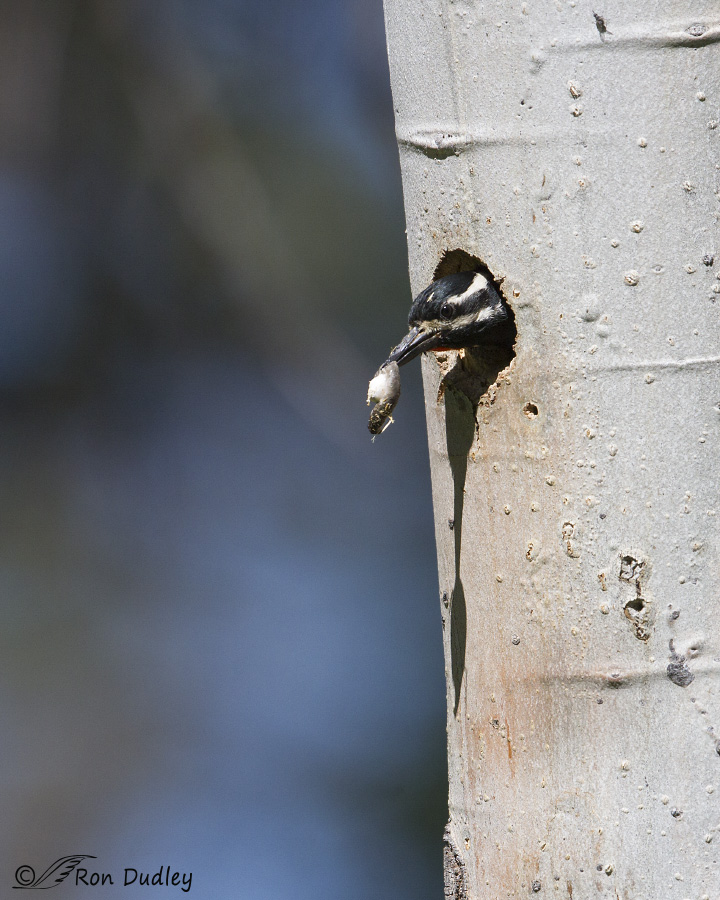
1/4000, f/5.6, ISO 640, Canon 7D, Canon EF 500mm f/4L IS USM, not baited, set up or called in
Both sexes did their part when it came to housecleaning. Here the male is about to leave the nest cavity with a fecal sac from one of the chicks. Fecal sacs were always carried far away from the nest tree before being discarded.
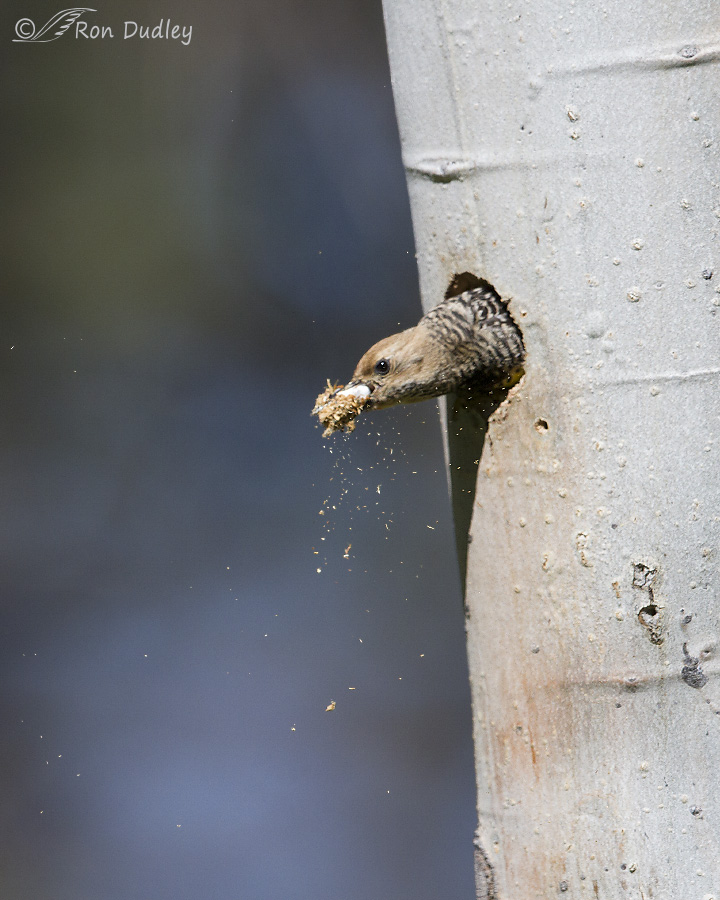
1/4000, f/5.0, ISO 640, Canon 7D, Canon EF 500mm f/4L IS USM, not baited, set up or called in
Often the adults had a mix of both fecal sacs and wood chips in their bills that were carried off. The parent birds were constantly enlarging the interior of the cavity as the youngsters grew larger (I could hear them chipping away from my position outside) so those chips needed to be discarded. I could tell they were soaked in wastes so it’s an effective method of keeping the cavity clean. This image isn’t very sharp but it demonstrates the behavior from the female.
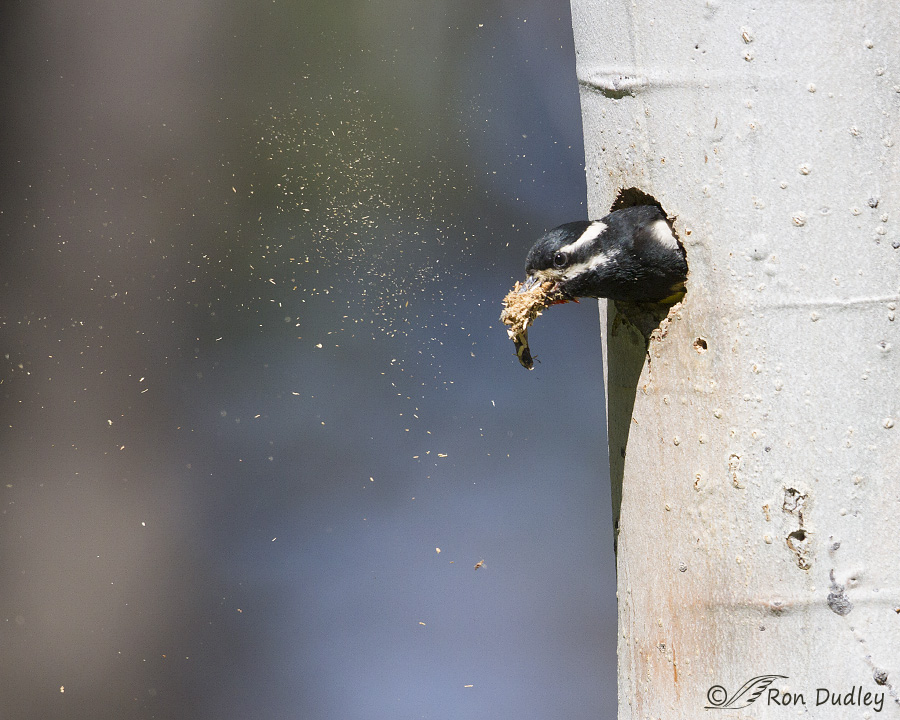
1/5000, f/5.0, ISO 640, Canon 7D, Canon EF 500mm f/4L IS USM, not baited, set up or called in
Here the male is doing the same thing with his load that contains both wood chips and a fecal sac. He would often shake his head to lighten his load of wood chips before flying off with the sac and whatever chips remained in his bill.
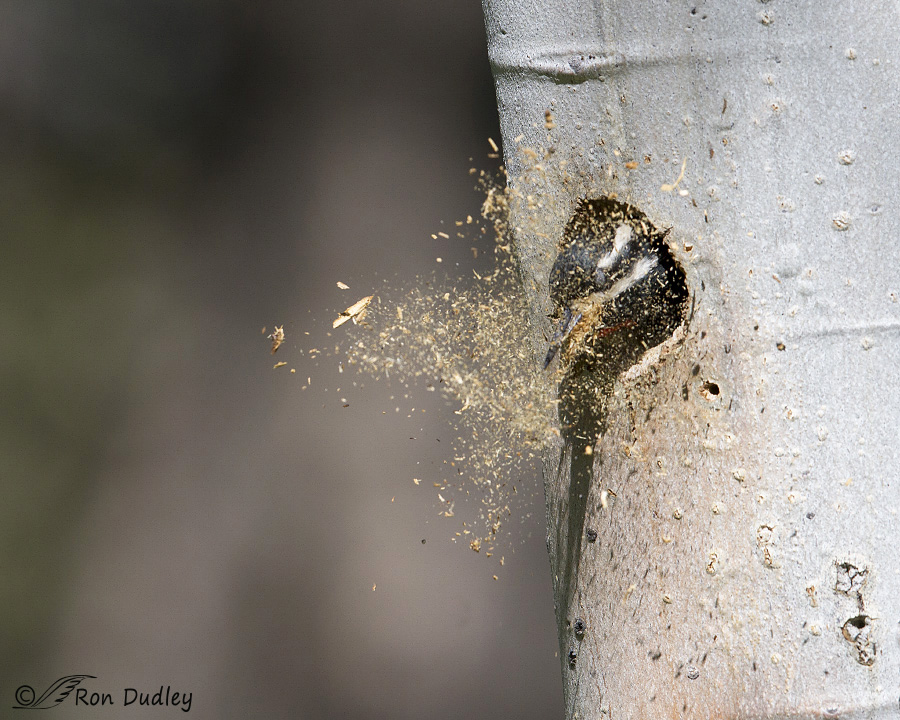 1/2000, f/6.3, ISO 640, Canon 7D, Canon EF 500mm f/4L IS USM, not baited, set up or called in
1/2000, f/6.3, ISO 640, Canon 7D, Canon EF 500mm f/4L IS USM, not baited, set up or called in
However, when they were excavating the cavity interior and had to get rid of those clean chips they would simply shake their heads and drop their load at the base of the tree without exiting the cavity. At times I could barely see the bird through all the flying chips. This behavior was very difficult to capture because the parent would appear so suddenly at the exit and begin shaking off the chips before I even had time to react. You can see that his nictitating membrane is closed to protect his eye.
Each of the images above was taken in the summer of 2014.
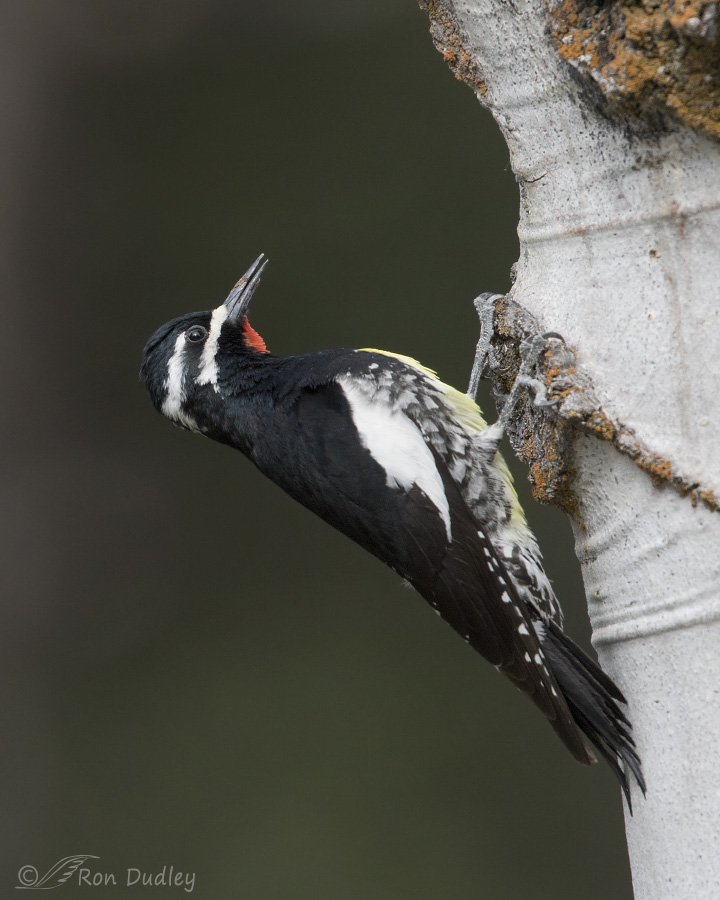
1/640, f/7.1, ISO 800, Canon 7D, Canon EF 500mm f/4L IS USM + 1.4 tc, not baited, set up or called in
In May of 2015 I returned to the area and was delighted to find what I believe to be the same male sapsucker at the nest tree. He was apparently competing with a pair of Northern Flickers for the cavity. This is among the last images I ever took of either of the sapsuckers because when I returned in June the nest tree had been chopped down by campers for firewood and I found broken eggs inside the nest cavity. The callous idiocy of many of my own species never ceases to depress me.
There’s more on that sad story here if you’re interested (many readers have seen that post before). But prepare yourself if you decide to visit because it’s a heartbreaker.
Ron


Wonderful series of photos and commentary
Beautiful photos but the story is very sad. I filled up with tears reading this as did with the original post. People like that just don’t care or have no brains or both. Not that it would matter, but I wish you had a way to let those people see your posts and see what they did to one loving couple who just wanted to raise their babies.
Excellent series Ron! Sorry I didn’t post earlier – too busy! I thought once your retired life is supposed to get easier?? Not so today!!
I have to admit that I really enjoy these behavioral shots.
Thanks, Dick. As far as I’m concerned, behaviors rock!
Hope you get back into real retired mode soon…
Where do I start?? This is yet another fantastic photography / bird behavior series, Ron. I have reviewed many of your posts since I found your blog sometime in November. In my opinion, you stand alone in having exceptional and unique imagery of this type. I admire lots of photographers, but you’ve got the skill (complimented by good light), the intense curiosity and appreciation of natural history and the patience to create one-of-a-kind mini documentaries. After scouring many sources over the last few years, I think you take the cake (chocolate donut, maybe?) for outstanding bird photography. Though I’m a relative newcomer to the site, whether I comment or not, this is one of my first stops every morning (unless I’m going out shooting).
I so agree with you on so many of the points you’ve made in this series. However, after reviewing a good portion of your archives, I find myself nodding in agreement with most of your thoughts and observations. As recently as yesterday (when I saw a bluebird just ahead of a Western NY Lake Effect snowstorm), I ponder your points in the field. Your insights are helping me become a better photographer.
Thanks too for introducing me to the Williamson’s Sapsuckers. They’re a new species to me and you’ve done them proud with this series!
Happy shooting; may you sift through these treasures for years to come!
What a nice, thoughtful comment, Kim. You’ve summarized nicely my intentions with this blog – to match my interests of a mix of aesthetic photos, documentation of behaviors and discussion of photography technique. Goes to prove you’re paying attention and as a retired teacher that’s something I always valued highly. 🙂
Thank you very much.
Simply sensational shots Ron!
Charlotte
Been out early today, Ron & just now reading & viewing your series of photos on your blog. I learned a lot from this series but have a question. Can you tell me/us about the fecal sac? With the eagles, very early the hatchlings instinctively know to back up to the side of the nest, point their butt up and do what I like to call an “aim & shoot” just like the adults. With cavity dwellers, how is the sac formed so their waste doesn’t get all over? I did go back to your blog and read it again which brought my blood to a boil again. I wish the people who oversee that property could have marked nesting cavity trees with “Nesting tree – DO NOT TOUCH”!!! I also read again the story on the Female Prong Horn deer who was protecting her babies. She went after a dog that it’s owner was walking without a leash!!! That one made my blood boil too. “Some” humans are lower than low and only care about themselves. As I’ve grown older (turned 70 yesterday!!) the number of humans who have developed such strong entitlement attitudes are having a terrible affect on our world!!
“Can you tell me/us about the fecal sac?”
Jo Ann, the fecal sac is a mucus membrane surrounding the feces of many baby birds, particularly passerines who spend a long time in the nest. The sac forms around the wastes before it is expelled from the bird and it makes it easier for the adults to dispose of those wastes. In some species the parents pluck the sac from the cloacal opening during the process of expulsion or very soon after.
Thanks so much for sharing that info with me, Ron – so appreciate it.
Awe and wonder. Teemed with ballistic rage because I remember the story well.
Behaviour is always fascinating. And how I wish that some of those who believe (for reasons I don’t understand) in human superiority would look at these images. Look and learn.
You’re kinder than I am, Ellie Baby. I wish they’d implode–and the dust would blow away……
Right on, Patty!! Maybe have those who might be salvageable be assigned community service at their local wildlife Rehab center – and not just for a couple of weeks – they need to do a year’s worth!!
Yeah, that human superiority thing…spend some quality time with a redtail hawk and she’ll ‘splain to you in words of one syllable so you can understand that you are indeed NOT at the top of the food chain, adding “Get over yourself!” 😀 And personally, I’m good with that. Takes a lot of the pressure off for being the best and baddest! LOL!
Sad to say, EC, I don’t believe that those types will ever learn…
I don’t want to wish you more bad photo weather, BUT, if there is mote and you take another archive dive, I hope some urrowing Owls images are among those that resurface….just a hint…..so far, you’re really high scoring on repeats…. 🙂
“I hope some burrowing Owls images are among those that resurface”
Prepare yourself, Patty. If I do there’s likely to be barbed wire in at least some of the images.
Again, a bittersweet posting…love the images,especially the chip storm and the explosive exit…hate the background story–makes me angry and depressed…too chicken to open the link…(already suffer from too high BP, and am pretty sure viewing it isn’t going to be a good thing, considering)…..
I don’t blame you for not opening it, Patty. Besides, you’ve seen it before and there’s no need adding a few points to your BP.
Once again, just WOW! What an outrageously splendid series. I’m always fascinated by critter parental activity. They’re such good parents and we humans need to learn from them.
As for the rest of the story, I’m not going there. It’s best I don’t know the details. I get all homicidal and snarky when folks do deliberate harm–and we’re SO good at it. Our species is just (overall) dumber than a box of paper clips (except that paper clips are useful–my apologies to the paper clip community). I’ve rehabbed so many birds due to the direct activities of humans, like chimney swift newborns because humans don’t have the sense to wait for them to finish nesting before they clean out their chimneys. You really do NOT want to get me started on this issue.
“I get all homicidal and snarky when folks do deliberate harm”
That pretty much describes how I felt when I saw that the nest tree had been cut down, Laura.
Kinda sad that feeling (homicidal and snarky) is so socially unacceptable, isn’t it? Our gene pool certainly needs some chlorine! 😀
Wonderful series and highly instructive! I’ll never complain about the kinds of housecleaning I need to do again. At least I don’t have to use my mouth! 🙂
I’ll not visit the heartbreaking details either. Egocentricity is a fatal flaw in us humans, and I’m sad enough about that already… have a good day, and thanks for your conscientiousness. I wish we could clone you!
“At least I don’t have to use my mouth!”
Ha, that brought a smile, Alison. And an interesting visual that I don’t think I’ll dwell on! Thank you.
Absolutely wonderful series, Ron. Thank you. I’m not sure I can visit the rest of the “stupid human” story. What you said above is sad enough.
“I’m not sure I can visit the rest of the “stupid human” story”
I knew it would be difficult for some, Carol – that’s why I gave the warning I did. Each reader will make their own choice. Thanks for the kind words about the series.
Is there something sticky on their bills to keep the ants from crawling away? Wish I had not read the last paragraph.
“Is there something sticky on their bills to keep the ants from crawling away”
I don’t believe so, Jo. Their bills latch onto both the bodies and the many long legs of the ants. I’ve always wished I could watch these birds when they’re gathering ants just to see how they do it.
I believe some of the group have sticky saliva and most have barbs on the tongue. I am not an expert just observation and reading what is online.I am always open to new information.
Great behavior shots, Ron. 🙂 “May the bird of paradise…..” to the fools that have to destroy habitat!
“May the bird of paradise……”
Well said, Judy. And I hope they choose a body orifice other than their nose…
Ron, in reference to yesterday’s and today’s blog, I wondered how these woodpeckers manage to eat ants despite the ant’s formic acid. I have also seen thrushes in South Africa feeding ants to their chicks. Are there ants without the acid? Or do the birds have a strategy to get rid of it or are they immune to it? Sorry if someone else already asked this.
Ricardo, As far as I know all ants contain formic acid but I don’t know how some birds tolerate it when they eat ants. As you probably know many bird species actually use that formic acid in the behavior called “anting”…